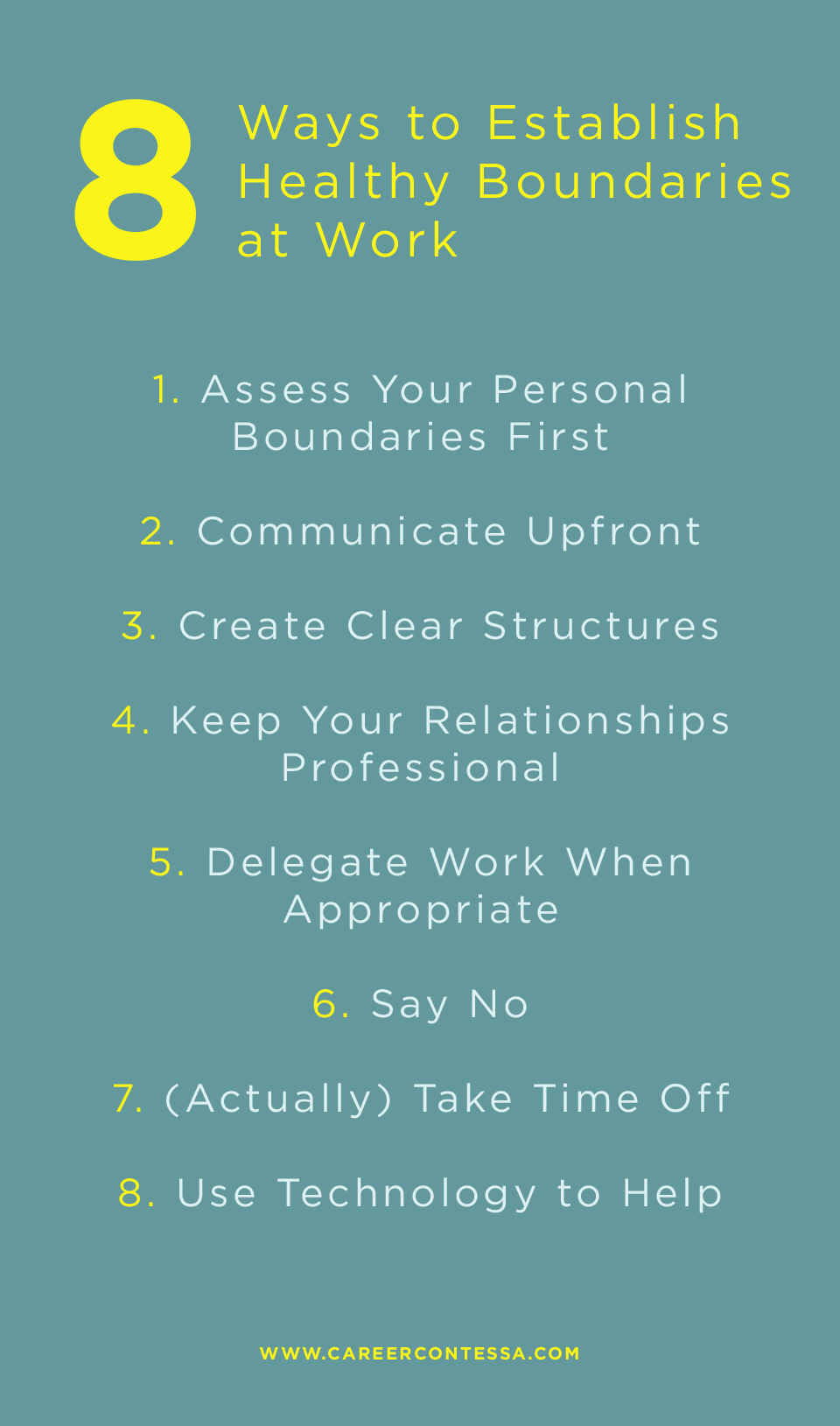Photo collage by Aliya Kamalova
With technology, flexible work, and ever-changing workplaces, setting healthy boundaries at work is more difficult than ever before.
Going through a
job search can be a difficult time—and, unfortunately, a time when you veer more towards
people-pleasing than asserting yourself. We all want the job, so we should be as agreeable as possible, right? Well, not really.
This is all to say that setting healthy boundaries for yourself at work starts early—as early as the
interview process itself.
Table of Contents
From the interview onward, you teach your boss and your colleagues how to treat you and how you achieve a healthy work-life balance by implementing physical boundaries, mental boundaries, and personal limits.
Here are a few common boundary breakers that we've all likely allowed in the past.
- Do you check your work email outside of office hours?
- Do you make yourself available on Slack 24/7—to solve any problem that might arise?
- Will you pick up work outside of your job description at a moment’s notice?
Setting boundaries from the start allows you to navigate your workplace, avoid potentially
toxic environments, and create a clear path to do your best work without being taken advantage of or
burning out.
No two people have the exact same work style.
It’s important to keep that in mind and to set your own boundaries. Ask
your local introvert and they will tell you exactly how important it is to protect your emotional energy and interpersonal boundaries.
Types of Boundaries to Set + Protect
If you're confused about what boundaries to set, we are here to differentiate healthy boundaries from what could be unreasonable requests. It's extra work, and it might feel unnatural at first, but preemptively protecting your mental health is so important.
Physical Boundaries + Examples
Let's start with physical boundaries. Why? Well, if you're having trouble with physical boundaries at work, then it's likely that all of your boundaries are being stomped upon.
- Offer handshakes over hugs.
- Don't attend any "work events" after 7:00 p.m.
- Take your after-lunch walk alone (maybe with your favorite podcast).
- Say no to working on the weekends.
- Take your sick days and your mental health days.
- Have a "tell" to show other employees that you're busy (i.e., wearing over-hear headphones or closing your door).
Mental Boundaries + Examples
Anybody who has slogged from the 3:00 p.m. slump all the way to 6:00 p.m. knows that mental energy is important—and it can be used up quickly by nonsense. Here are boundaries to see to preserve your mental juices.
- Set your working hours—and stick to them.
- Decline superfluous meetings (and encourage management to run more efficient meetings.)
- Set away messages when engaged in deep work mode.
- Do not engage in anything that can be perceived as gossip—especially about others in your workplace.
Emotional Boundaries + Examples
Emotional boundaries can be tough to pinpoint, but it's so crucial to do this work. By setting emotional boundaries, you're giving yourself permission to disallow someone else's bad day to affect yours.
This doesn't mean that you cut out
empathy or understanding. Rather, it means that the next time Bill is yelling and throwing his papers around in his office, you can keep your head down. Here are more examples of emotional boundaries at work.
- Communicate upfront how you like to give and receive feedback.
- Do not imprint on someone else's bad mood or outburst.
- Delegate work when necessary.
- Create a schedule that prioritizes the balance in work-life balance.
How to Set Professional Boundaries with Coworkers
A lack of boundaries can be especially harmful to your relationship with your coworkers. Clear boundaries with coworkers can safeguard your time, energy, and overall comfort in the workplace.
Common consequences of a lack of boundaries with coworkers include:
- Taking on the workloads of others
- Getting caught up in personal issues
- Blurring the lines between your work and personal hours
- Increased gossip in the workplace
Boundaries are good for you and the people you work with. When you set clear boundaries and stick to them consistently, it can help ease any difficult or awkward work situations.
To set professional boundaries with your coworkers, you must clearly communicate what your boundaries are. For example, if you have a coworker who loves to spend time after lunch chatting, but you really need to get work done, gently remind them that although you enjoy talking with them, you really need the afternoon to get some heads-down work finished.
If you feel that there is a consistent problem, have a conversation about it. Talk to your coworker about how you’re feeling, and then provide a few solutions. An in-person conversation prevents a problem from unnecessarily escalating.
Setting expectations and boundaries is especially crucial when dealing with a group project or assignment. In order to prevent any bumps down the road, make sure to be clear at the start of the project about who is doing what. Create a shared document that outlines project roles, deadlines, and timelines, so that everyone on the team can reference it in the future.
When all else fails, learn to say no. While simple in theory, saying no can be quite difficult in practice. It can feel like an entire art form.
When in doubt try some simple and solid responses like these:
- I can’t help you. I am swamped for the next few weeks.
- No, I have no space for additional work at the moment.
- No, I am on several deadlines.
How to Set Professional Boundaries with Your Boss
Since there is a bit of a power dynamic in play, setting boundaries with your boss can be slightly more complicated. It’s difficult to say no to your boss when they’re reaching out to you after hours or piling on more work than you can handle now.
The best way to set professional boundaries with your boss is to approach the situation empathetically. Give them the benefit of the doubt that they may not have been aware of your workload or whatever boundary you set for yourself.
There are many ways to get through to a difficult boss, but the overarching theme is good communication. If you receive pushback from your boss, present some potential solutions while sticking firm to your boundaries:
“It is after my work hours, so I won’t be able to get around to this tonight. However, I have everything prepped and I’d be happy to put this on the top of my to-do list tomorrow morning. We should have it to the client by tomorrow afternoon.”
While technology has made us more reachable than ever, try to use it to your advantage. Many messaging platforms have built-in “do not disturb,” “snooze,” or “schedule send” features. If you have a public calendar, book solo time for when you need to focus or out-of-office times for when you are completely away.
8 Ways to Establish + Keep Healthy Boundaries at Work
Okay, but how do you actually set your list of boundaries? Here are eight ways to prioritize, implement, and honor your boundaries—by infusing them into your daily interactions and your everyday routine.
1. Assess Your Personal Boundaries First
Before you communicate your boundaries, you’ll have to take the time to assess them, their limits, and how to set them.
Your personal boundaries will stem from your values and your life’s priorities.
Any job worth having (in our humble opinion) recognizes that it is, first and foremost, a job.
Aside from your work, you have your home life, your relationships, your passions, and your personal space to consider.
In Doctor Dana Gionta’s book,
From Stressed to Centered, she offers a step-by-step process for assessing personal boundaries at work:
- Know your limits
- Pay attention to your feelings
- Give yourself permission to set boundaries
- Consider your environment
2. Communicate Upfront
Once you have your priorities and values in place,
communicate them. This can be as simple as letting your team know that you do not answer emails after 7:00 p.m.
You can also use this time to communicate what constitutes a work "emergency" so that you're not fielding "crises" that pop up in your off-hours.
Communication is the thread throughout each additional tip in this article. When you take the steps to communicate upfront, you are safeguarding against future potential miscommunications.
3. Create Clear Structures
Structure is important in the workplace. You're the architect of your own boundaries, so build them solid.
By creating clear boundary-based structures upfront, it takes any guesswork out of common boundary infractions. Your coworkers are less likely to
interrupt your work if you set up blocks of time in which you are engaged in do-not-disturb work.
If you're in a
management role, you might create structures that include building out team responsibilities. This creates clear guidelines for where (and with whom) responsibility lies in a variety of circumstances.
4. Keep Your Relationships Professional
We all love having a
work wife or a work BFF, but sometimes those relationships get tricky—and convoluted from the perspective of boundaries.
Now, we’re not saying you shouldn’t have an at-work confidante or close friend. What we are saying is to mind that your work relationships remain, by and large, professional.
5. Delegate Work When Appropriate
One important part of establishing boundaries is in setting expectations about the work you will do, that you’re hired to do, the work you’re willing to pick up (part of being a “team player”), and the work that is outside of your responsibilities.
When work is entirely outside of your scope of responsibility, you might have the opportunity to say no (we’ll get to that in our next point) or delegate the work to someone who is more suited to the work.
Obviously,
delegating work is a bit easier to navigate when you’re already in a managerial position.
When you’re not a manager, you can still delegate work. Ask yourself a few questions to qualify whether or not the work is better completed by someone else.
- Do I have the time to complete this work without compromising the main functions of my job?
- Is there someone else on my team better suited or looking for an opportunity to grow by completing this specific work?
- Is this a job or task that can be justifiably delegated to someone else with a lesser workload so that I can perform my job at the optimum level?
6. Say No
Sometimes, your established boundaries won’t even require you to actually delegate the work. In these cases, you can just say—and this is a tough one for many of us—no.
Saying no is a lot easier said than done, especially in a professional atmosphere.
In an
episode of
The Career Contessa Podcast, where we interviewed former hostage negotiator Christopher Voss, he introduced us to a helpful tactic when someone asks for something that is outside the realm of possibilities.
Voss explains that, when you need to decline a project or task, you can ask, “How am I supposed to do that?”
It’s important not to ask this in an accusatory way, but, rather, in a way that elicits a little
empathy from the other party.
It’s in explaining the scope of work you do have—and in exploring whether you can fit in more work without having your primary responsibilities suffer.
By asking this question, you're giving the other person a chance to consider the work you do have—and whether adding more (or interrupting it) is actually feasible.
7. (Actually) Take Time Off
Another great way to set boundaries is by taking your time off—when you get it, when you need it, and when it’s offered. Letting vacation time accrue and expire is not a point of pride—nor should it be.
Use the time you're given. You've earned it. When you do, set that perfect
out of office message and take time to recharge.
In the long run, your career will only benefit from a rested you.
8. Use Technology to Help
Do you know who is great at setting boundaries? Technology. Use it as a tool to help you set certain boundaries.
At Career Contessa, we are all huge fans of creating status updates that communicate where we are, what we’re up to, and whether or not we’re available at that moment.
Technology can be great at helping you create structures. It can be putting up an away message on your Slack when you’re deep into writing.
It can be blocking off a few hours a week on your calendar in which you are engaged in specific work—and thus, unavailable to be bothered. You can also use tools to set your working hours—which will notify your coworkers of the hours in which you are, in fact, working.
Technology can also help when you’re dedicated to taking an actual vacation. You can set up systems and chains of command for your time away—and communicate that to your team before venturing off.
Bonus Tip: Prepare for Boundary-Breakers
While you’re out there setting boundaries, you will experience pushback and infractions.
Building boundaries is not an overnight process—and some people are unaware that they're constantly crossing them—like that coworker who taps your shoulder when you're deep in work with headphones on.
Don't view boundary-breaking as a step back. Instead, use it as an opportunity to instruct your coworkers on how you best communicate, when it's appropriate to disrupt you (if ever), and what they can realistically expect from you.
What to Say When a Boundary Is Broken:
"Per my calendar, I am in deep work from 12:00 p.m. until 2:00 p.m. today. I made my calendar public if you'd like to find space to connect later on this week."
"I am out of the office on vacation, but you can connect with [NAME] and they can help you with this matter."
"In order to do my best work on this project, I cannot take any additional projects right now. I'd be happy to help in the future, but I need a week's notice to fit additional work into my schedule."
However, if you find that your boundaries are repeatedly—and aggressively—disregarded, you might be working in a toxic environment that can't be helped. In that case, it might be time to
explore new options.












